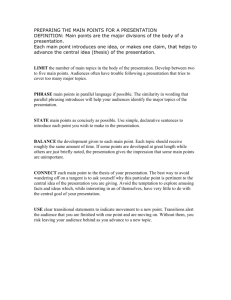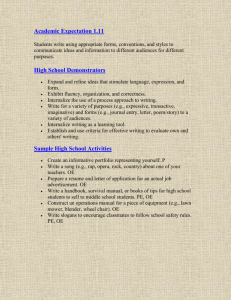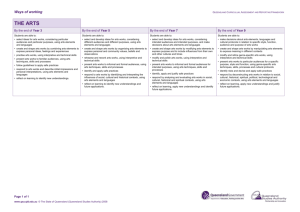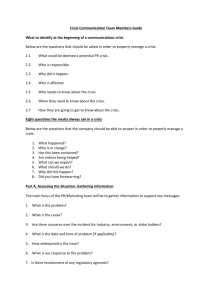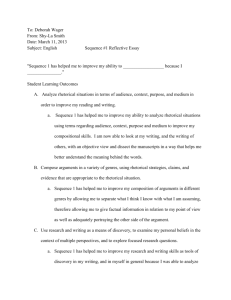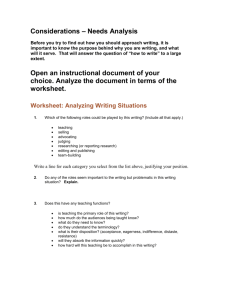scope and sequence of content - School Curriculum and Standards
advertisement
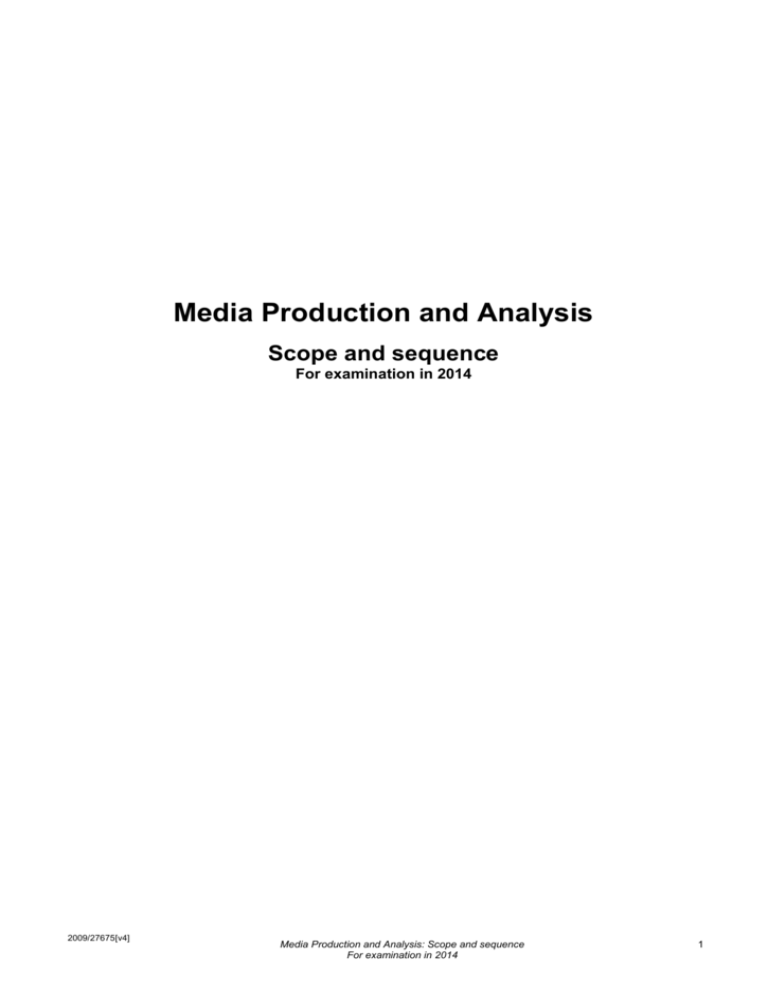
Media Production and Analysis Scope and sequence For examination in 2014 2009/27675[v4] Media Production and Analysis: Scope and sequence For examination in 2014 1 Copyright © School Curriculum and Standards Authority, 2009 This document—apart from any third party copyright material contained in it—may be freely copied, or communicated on an intranet, for non-commercial purposes by educational institutions, provided that it is not changed in any way and that the School Curriculum and Standards Authority is acknowledged as the copyright owner. Teachers in schools offering the Western Australian Certificate of Education (WACE) may change the document, provided that the School Curriculum and Standards Authority’s moral rights are not infringed. Copying or communication for any other purpose can be done only within the terms of the Copyright Act or by permission of the Authority. Copying or communication of any third party copyright material contained in this document can be done only within the terms of the Copyright Act or by permission of the copyright owners. Disclaimer Any resources such as texts, websites and so on that may be referred to in this document are provided as examples of resources that teachers can use to support their learning programs. Their inclusion does not imply that they are mandatory or that they are the only resources relevant to the course. 2 Media Production and Analysis: Scope and sequence For examination in 2014 Media Production and Analysis—Scope and sequence of content UNIT 1A Personal experience UNIT 1B Introduction to point of view UNIT 1C Entertainment UNIT 1D Infotainment Media language Media form introduction to key terminology including codes and conventions and new technologies purposes and characteristics of familiar fictional media work familiar viewing and listening contexts introduction to basic communication model. reinforcing key terminology, new technologies, purposes and basic characteristics of familiar non-fiction media work media forms appropriate to audience viewing, reading and listening contexts. Narratives, codes and conventions Representation basic narrative elements i.e. character, setting, conflict, resolution common codes and the meanings they construct features and audience expectations of popular genres simple editing techniques. stars and heroes and the values they represent how familiar stereotypes are constructed common stereotypes as short cuts to meaning. personal experiences influence media use making links between media work and own experiences identifying the purposes of media work and relating purpose to own reading context. codes and conventions used in nonfiction media work selection processes and point of view. stereotypes in non-fiction media work processes of selection and omission in simple media work. terminology, technologies and characteristics of specific media advantages and limitations of different media features of commercial and noncommercial media viewing, reading and listening contexts audience expectations and use of media. narrative elements, structure and genre conventions genre recognition and audience expectations technical, symbolic, audio and written codes that position the audience and construct meaning editing conventions. how groups are stereotyped in media why the media use stereotypes representations and stereotypes in different contexts e.g. comparing past and present representations how stars and celebrities are represented to reflect mainstream and subcultural values. representation of people and events representation of subcultures construction of stereotypes through selection and over-simplification resulting in negative and positive stereotypes. personal experiences that shape own media preferences and the reading of media work how different audiences use media how the purpose of the media work and the reading context influence audience response and interpretation. use of media, preferences and expectations of specific audiences comparing cultural experiences and meanings made by audiences how different reading/viewing/listening contexts influence audience responses to media work. characteristics of media in different times distribution/transmission of specific media: speed, accessibility and audience reach. codes and conventions in non-fiction genres narrative elements and narrative structure in non-fiction media work codes and conventions used to construct a point of view. Audiences Readers’ social and cultural experiences identifying and explaining personal points of view about familiar nonfiction media work identifying reasons for different points of view held by familiar audiences. Media Production and Analysis: Scope and sequence For examination in 2014 3 UNIT 1A Personal experience Values, attitudes and ideologies Subcultures Past, present and emerging trends UNIT 1B Introduction to point of view using codes and conventions to construct values identifying values in representations linking values in media work to audience values. identify familiar subcultures examples of familiar subcultures and how they can be identified. changing trends of media platforms current popular media and genres how audiences respond and interact with new media. UNIT 1C Entertainment values in representations linking values in non-fiction media work to point of view and values of audience. subcultures as intended audiences subcultures and point of view. impact of new technologies on media and audiences impact of changes in technology on familiar non- fiction media. UNIT 1D Infotainment how values are depicted in popular media through genre and representations connecting values in popular media to mainstream cultural values. identifying subcultures based on cultural background, experiences, interests and occupations representations and stereotypes associated with subcultures. past and current popular media and audience expectations impact of new technologies and globalisation on audience reach, audiences and media use. attitudes, beliefs and values of specific cultural and subcultural groups identifying values in non-fiction genres and linking them to audience values. subcultures as target audiences linking values depicted in media work to the beliefs of specific subcultures subcultures and alternative interpretations of mainstream media. impact of new technologies on existing media and on audiences in different cultural contexts impact of networking and the internet on media services and audiences. Production context Institutions and independents purposes of commercial media production styles and formats. comparing commercial and noncommercial media in terms of format, style and audience. comparison of commercial and noncommercial entertainment media in terms of: budgets, sources of revenue, production costs marketing strategies production styles and formats. comparing commercial, noncommercial and independent nonfiction media in terms of: opportunities and limitations production roles and responsibilities sources of revenue, style of production audiences. Media use and target audience targeting mass audiences to ensure profit promoting media products measuring the popularity of media work. intended audiences for non-fiction genres and media marketing of media products and measuring audience reach. media use by different audiences targeting mainstream audiences measuring audience use. target audiences and marketing strategies for non-fiction media media in the workplace. Cultural contexts linking popular media work to a particular time and place to appeal to a mass audience. considering the needs, interests and values of familiar audiences when constructing point of view making links between a particular context and the point of view constructed in media work. making links between popular media work and their cultural contexts. 4 Media Production and Analysis: Scope and sequence For examination in 2014 linking media work and styles to the cultural context at the time of production. UNIT 1A Personal experience Controls and constraints classifying media products to meet accepted standards controls and constraints in a familiar media production context. UNIT 1B Introduction to point of view UNIT 1C Entertainment UNIT 1D Infotainment standards appropriate to: school’s expectations audience expectations limitations in a familiar production context i.e. access to technology, cost, time. ethics in the media controls in a familiar media production context. collecting and communicating information for a specific task awareness of safety procedures when using technologies and resources team skills i.e. specific role responsibilities and setting timelines applies a clear production process i.e. applying technical skills and processes reflecting on production processes evaluating strengths and weaknesses in the production. collecting, interpreting and communicating information within given contexts safe procedures when using technologies and resources team skills i.e. active listening, making decisions, goal-setting, time management, production responsibilities applies the production process i.e. application of technical skills and processes, simple scripts and storyboards or layout design reflecting on production processes evaluating strengths and weaknesses in the production. constraints in commercial and noncommercial media audiences’ values impacting content. Skills and processes collecting information for a specific task awareness of safety when using technologies and resources team skills i.e. specific role responsibilities and setting timelines follows a clear production process i.e. basic technical skills and processes, basic scripts, storyboards and layouts reflecting on the progress of the production evaluating strengths and weaknesses in the production. Media Production and Analysis: Scope and sequence For examination in 2014 investigating, assessing and communicating information within given contexts safe procedures when using technologies and resources team skills i.e. collaboration and negotiation within the team, goalsetting, time management, production responsibilities applies the production process i.e. pre-production, production and postproduction roles, skills and processes reflecting on media production processes evaluating strengths and weaknesses within the production. 5 UNIT 2A Popular culture UNIT 2B Press and broadcasting UNIT 3A Media art UNIT 3B Power and persuasion Media language Media form Narratives, codes and conventions Representation differentiating between media form and content media in different cultural contexts, including Australia impact of new technologies on popular culture evolution of media. narrative conventions in different genres including characters, settings, conflicts, resolutions and structures comparing genres from different times and cultures using codes and conventions to construct preferred meanings and change audience viewpoint realism in fictional narratives including continuity and montage. representations in different times and cultures linking stereotypes to the values of mainstream and subcultural audiences the effect of using stereotypes. technologies and production processes in different media media ownership, sources of revenue and commercial expectations of particular forms audience reach, accessibility and audience interaction. alternative and experimental media in terms of: artistic and aesthetic benefits impact of funding on production publicity, avenues for exhibition, transmission intended audiences. suitability of particular media for audiences and for purposes such as social or political comment. narrative conventions in media work codes and conventions to construct realism constructing preferred meanings, values and point of view. non-realist narratives multiple plots, multiple viewpoints, manipulation of narrative structure, chronological order codes, conventions and aesthetic values. constructing meaning through the use of codes and narrative conventions extended narratives manipulating selection processes to construct different points of view. representation of minority groups stereotypes as judgmental representations that serve the interests of particular groups connecting stereotypes to the cultural context selection processes including sources of information, presentation style, selection, omission and emphasis representation of issues. patterns of representation repetition and naturalisation of stereotypes social problems arising from stereotyping. social practices and cultural experiences that influence the reading of media work how different contexts influence the point of view of media work. how personal values and beliefs influence the reading and interpretation of media work including communication theories developing audience profiles based on cultural experiences, values and beliefs how different contexts or intended use of media work influence interpretations. comparing representations of the same issue in different media work dangers in the naturalisation of stereotypes. Audiences Readers’ social and cultural experiences identifying personal values that shape the reading of media work identifying the cultural experiences of familiar audiences that shape their values and the reading of media work mainstream and alternative readings. 6 Media Production and Analysis: Scope and sequence For examination in 2014 how understanding the process of construction enables the reader to make alternate readings of media work how media, cultural contexts and audiences work together to make meaning. UNIT 2A Popular culture Values, attitudes and ideologies Subcultures Past, present and emerging trends UNIT 2B Press and broadcasting identifying the values of particular subcultures and how they connect to mainstream attitudes and values linking stars and celebrities to value systems linking themes and values in specific genres to cultural context. representation of subcultures in the media particular subcultures’ media preferences. UNIT 3A Media art changing values and representations interrelationship between values, producers and audiences mainstream and subcultural value systems. comparing representations in media work produced for mainstream and minority audiences cult figures and subcultural values. UNIT 3B Power and persuasion cultural contexts that contribute to audience values and reading of media work values in the production and content of experimental and alternative media work. iconic figures and the values they embody. the impact of globalisation on media and audiences trends in past and present media production and consumption. current trends in media technological trends global access and issues of privacy and accuracy. comparing commercial, noncommercial media, in terms of technologies and audiences. characteristics, benefits and limitations of concentrated media ownership characteristics, benefits and limitations of independent media production. marketing strategies to target specific audiences links between target audiences and genres. access and media use by audiences. effect of other cultures’ media on the values and representations in media linking popular media to the Australian cultural context the impact of American or British or other international media on Australian media. how media construct perceptions of history how media work reinforces and challenges audience values, attitudes and ideologies. representation of subcultures and their associated values impact of particular media work on the representation of subcultures reasons for alternative points of view by select audiences. changing audiences, expectations and values impact of global interconnectedness on individuals and communities. media industry issues such as the profit motive and dominance of mainstream media institutions. aesthetics, personal expression and niche audiences the impact of media access and interaction on societies and individuals. techniques to persuade audiences the construction of political and social comment to persuade audiences. comparing media aesthetics in different cultural and historical contexts cultural and ideological influences that have contributed to changes in media. treatment of issues in different cultural contexts the impact of social, historical and political contexts on and in media work. the impact of current trends in media production and consumption the impact of globalisation on cultural identity. Production context Institutions and independents Media use and target audience Cultural contexts comparing cultural influences on media work cultural factors that bring about changes in media style and content. Media Production and Analysis: Scope and sequence For examination in 2014 influences on commercial, noncommercial and independent media impact of editorial control and bias. 7 UNIT 2A Popular culture Controls and constraints effect of budgets on technologies, production personnel, style of production censorship and classification and impact on audience values and expectations. UNIT 2B Press and broadcasting constraints imposed by mainstream and minority audiences ethical issues and legal consequences censorship and self-regulation UNIT 3A Media art UNIT 3B Power and persuasion regulations and ethical positions that shape media for particular audiences formal and informal censorship impact of budget constraints. regulation in the media propaganda and political censorship constraints imposed by values of audience. applying formal processes and selecting appropriate strategies to communicate ideas independent management of safety procedures in all production situations production skills i.e. independent management of time and technologies, management of team members, negotiating and adapting production processes, anticipating problems and applying effective solutions effectively applying skills within the defined production roles experimenting and manipulating genres, styles and conventions critically reflecting on production progress critically evaluating own and others’ productions i.e. peer and/or professional. applying formal processes and selecting appropriate strategies to communicate ideas independent management of safety procedures in all production situations production skills i.e. independent management of time and technologies, management of team members, negotiating and adapting production processes, anticipating problems and applying effective solutions effectively applying skills within defined production roles experimenting and manipulating genres, styles and conventions critically reflecting on production progress critically evaluating own and others’ productions i.e. peer and/or professional. effects of political pressures on the reporting of issues professional codes of behaviour. Skills and processes 8 investigating and analysing media knowledge and application of safety procedures production skills i.e. independent management of time and technologies, management of team members, negotiating and adapting production processes, identifying problems and applying appropriate solutions fulfilling defined production roles implementing production processes based on proposals, scripts and plans using conventional genres, styles and conventions reflecting on the production process evaluating own and others’ productions i.e. peer and/or professional. investigating, analysing and evaluating media independent application of safety procedures in all production contexts production skills i.e. independent management of time and technologies, management of team members, negotiating and adapting production processes, identifying problems and applying appropriate solutions refining skills within defined production roles implementing production processes based on proposals and plans manipulating genres, styles and conventions reflecting on the production process evaluating own and others’ productions i.e. peer and/or professional. Media Production and Analysis: Scope and sequence For examination in 2014



